superconductor
Latest
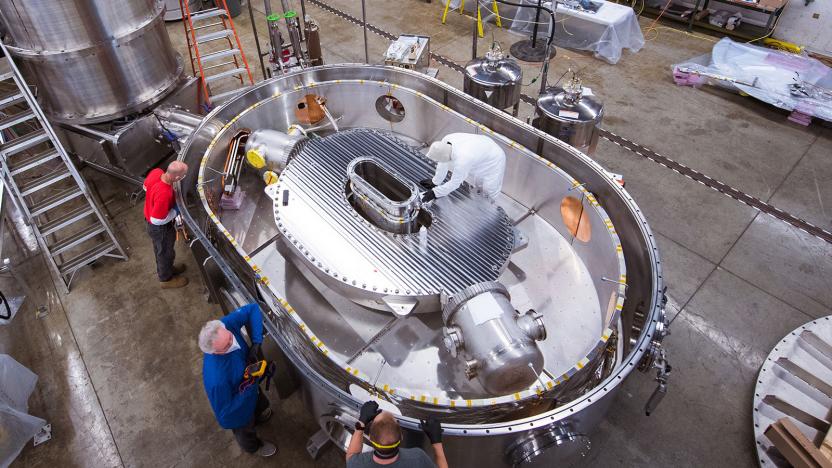
Fusion energy nears reality thanks to an ultra-powerful magnet
Fusion energy is closer to becoming a practical reality after researchers successfully tested an extremely powerful magnet.

Superconducting tape could lead to lower-cost wind power
Wind power is limited in part by how expensive it can be to make each turbine. You may need roughly a ton of rare earth metals per machine... and that adds up. It could soon be much less expensive, however. The EU-backed EcoSwing project recently upgraded a wind turbine in Denmark with superconducting tape that reduces the required amount of rare earth elements to as little as 1kg (2.2lbs). That not only dramatically reduces the costs (down from $45.50/kg to $18.70/kg), it reduces weight and size requirements. You can produce the same power for about half the weight and volume of a conventional turbine, the University of Twente's Marc Dhalle told Chemistry World.
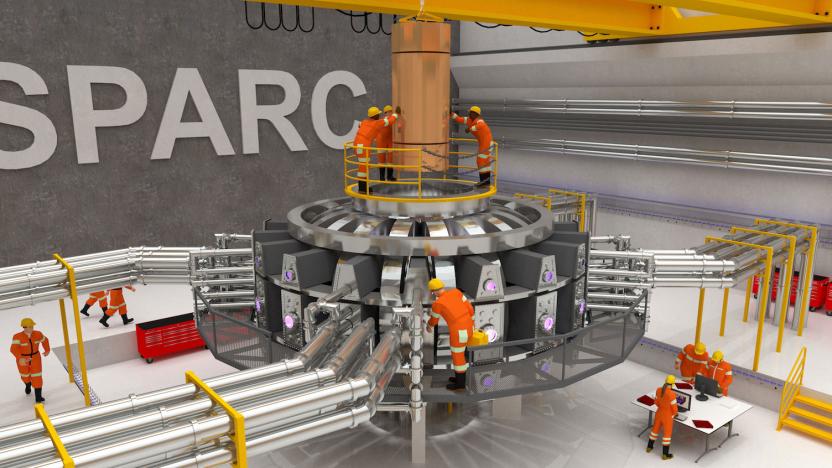
MIT embarks on ambitious plan to build nuclear fusion plant by 2033
MIT announced yesterday that it and Commonwealth Fusion Systems -- an MIT spinoff -- are working on a project that aims to make harvesting energy from nuclear fusion a reality within the next 15 years. The ultimate goal is to develop a 200-megawatt power plant. MIT also announced that Italian energy firm ENI has invested $50 million towards the project, $30 million of which will be applied to research and development at MIT over the next three years.
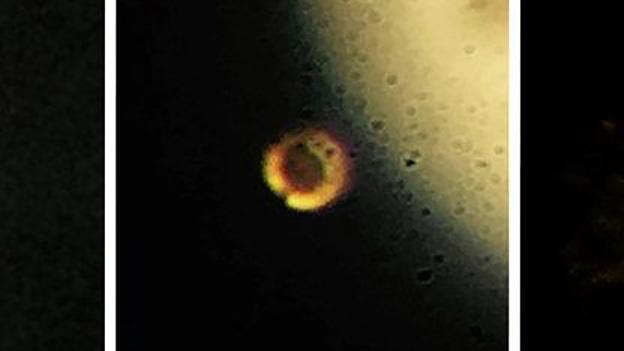
First hydrogen metal created on Earth draws critical doubt
Scientists from Harvard University say they've ended an 80-year quest by compressing hydrogen into a potentially superconducting metal. Using a diamond-tipped anvil, the team squeezed a hydrogen gas sample to 71 million PSI, more than the pressure at the Earth's core. "It's the first-ever sample of metallic hydrogen on Earth, so ... you're looking at something that's never existed before," says research lead Isaac Silvera. However, other scientists have reservations, saying it's possible the solid material they created (pictured above) is actually aluminum oxide that came from the anvil's diamond tips.
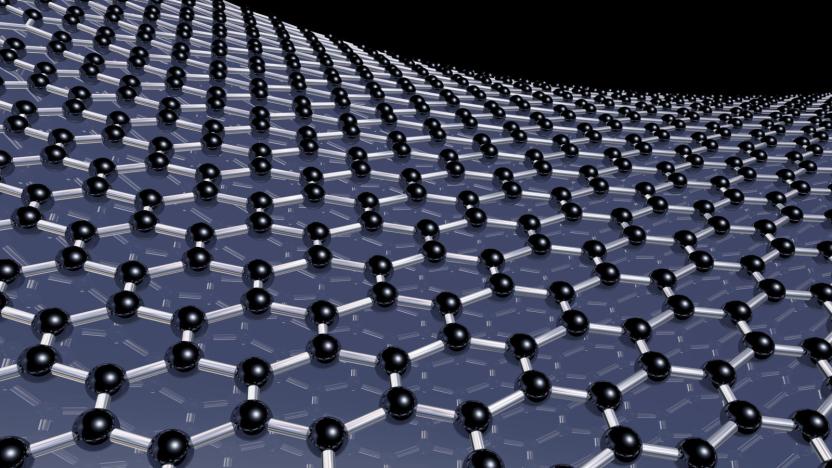
Researchers make a graphene superconductor
Graphene is the miracle cream of the physics world, with scientists all across the globe looking to unlock its powers. Researchers at the University of Cambridge believe they've found a way to transform the substance into a superconductor. Superconductors are nothing new, of course, but they normally have to be cooled to very low temperatures to be effective. In this experiment, however, the materials were left at the current temperature. Now, like so many graphene projects, it's still early days, but if it works, it could up-end the way we build electronics forever.

Scientists map high-temp superconductivity in 3D for the first time
High-temperature superconductivity represents a potential breakthrough across multiple fields of technology, from MRIs to levitating trains, hoverboards and computing. Scientists at the Department of Energy's SLAC National Accelerator Laboratory have discovered the first 3D model of the elements involved in high-temperature superconductivity, uncovered using powerful magnetic pulses and "some of the brightest X-rays on the planet," according to a press release. Superconductivity is a quantum mechanical phenomenon that occurs in certain materials when they're cooled to extreme temperatures, at which point they conduct zero electrical resistance and expel their magnetic fields. If humans can harness superconductivity at room temperature, the technology could take off in a massive way (Did someone say singularity?).

Scientists create a 'wormhole' for magnetic fields
Humanity is still a long way from creating space-time wormholes -- if they're even possible -- but that isn't stopping Spanish researchers from achieving something similar for magnetism. They've produced a wormhole-like effect that transports a magnetic field from one point in space to another through an "invisible" path. The trick was to transmit magnetic fields between two spheres linked by a multi-layer, spiraling cylinder whose materials hide the fields while they're in transit. It's as if they vanished, and then popped back into existence somewhere else.

Lexus let skateboarders put its hoverboard to the test
After weeks of teasing, Lexus is finally showing off its latest Amazing in Motion project in full. The Slide video posted today shows skateboarders riding the company's superconducting hoverboard at a specially built skate park in Spain. Similar to the $10,000 Hendo hoverboard before it, this board only works if you have the combination of a liquid nitrogen cooled cryostat onboard and a special magnetic track, so no -- it's not for sale. As you can see in the video, skaters who got their crack at it pulled off some cool gliding tricks (including one across a stretch of water), but it's still not quite the same thing as the decks that they're used to, and seemed to have less control available than the Hendo board. Back to the Future it ain't, but it's real, and it's cool (-197°C).

Lexus video teases a 'real' magnetic hoverboard
Yes, we know - it's 2015, the year Marty jumped to in Back to the Future 2 and you still don't have a hoverboard. Right on time, Lexus has presented the latest example from its "Amazing in Motion" series of video spectacles: the Lexus Hoverboard. As you can see in the video after the break, it certainly appears to hover, and smoke, but no one actually hops on the magnetically-levitating device for a ride. Gizmodo heard from the carmaker that this project has been in development over the last 18 months, but couldn't get more specific info on how it works.
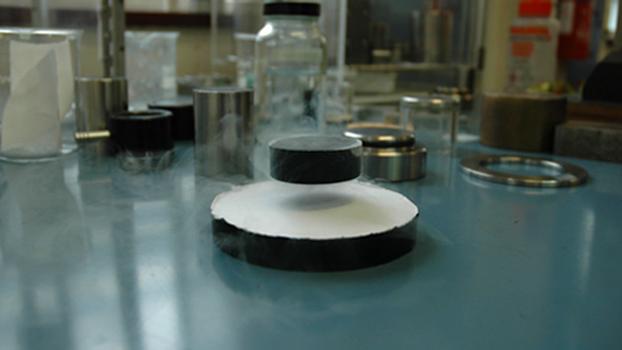
Record-breaking magnet crams three tons of force into the size of a golf ball
University of Cambridge scientists have broken a decade-old superconducting record by packing a 17.6 Tesla magnetic field into a golf ball-sized hunk of crystal -- equivalent to about three tons of force. The team used high-temperature superconductors that work at minus 320 degrees F or so -- not exactly balmy, but less frigid than the minus 460 degrees F needed for regular superconductors. With zero resistance, superconducting materials can carry up to 100 times more current than copper wires, but the resulting magnetic fields create huge internal forces. Since the cuprate materials used for the record are as fragile as dried pasta, they can actually explode under the strain. To get around it, the team modified the material's microstructure and "shrink-wrapped" it in stainless steel. That produced the largest magnetic field ever trapped in a standalone material at any temperature, according to the team. The research might eventually lead to more secure and efficient power transmission, better scanners and yes, levitating monorails. [Image credit: University of Cambridge]

Levitating superconductor floats within a magnetic field so you don't have to (video)
What happens when you douse a superconducting urinal cake with liquid nitrogen? We haven't given it too much thought, to be honest, though we're guessing it would look a lot like the "levitating" disc pictured above. Developed by researchers at Tel-Aviv University, this device is actually a superconductor hovering over a "supercooled" magnet. While locked within the magnetic field, it can rotate around a vertical axis, turn upside down or do laps around a track -- all thanks to a phenomenon that Tel-Aviv's physicists call "quantum trapping." We're not really sure what that entails, but we do know that the results are pretty incredible. Check them out for yourself, after the break. [Thanks to everyone who sent this in]

Superconducting sapphire wires are as cool as they sound
Copper wire's relatively cheap, pliable and can conduct electricity, but it's hardly ideal. Powering cities requires cables meters wide and the metal loses a lot of energy as heat. Fortunately, a team from Tel Aviv University thinks it's solved the problem. Borrowing a fiber of sapphire from the Oakridge National Lab in Tennessee, it developed a superconducting wire barely thicker than a human hair that conducts 40 times the electricity of its copper brethren. Cooled with liquid nitrogen, the sapphire superconductors carry current without heating up, which is key to their efficiency. The team is now working on practical applications of the technology -- because it's so small and pliable (unlike previous superconductors) it could replace copper in domestic settings and its cold efficiency makes it perfect to transmit power long distances from green energy stations. The wire's going on a world tour as we speak and will touch down at the ATSC conference in Baltimore in October. Anyone who makes jokes about wires and Baltimore will be asked to leave, politely.

Japanese doctor turns hot toddy into superconductor catalyst
It's rare that hot booze does anything more than get you drunk, and possibly make you sick, but according to Dr. Yoshihiko Takano, the drink you're sucking on could facilitate the levitation of a train. After a party for a colleague, the Japanese scientist found that FeTe0.8S0.2 (composed of iron, tellurium, and tellurium sulfide), when soaked in warm booze overnight, shows signs of increased superconductivity -- another in a long line of liquor-enhanced discoveries that could have far reaching effects on everything from consumer electronics to public transportation. Dr. Takano decided to test the material (known to become a superconductor after soaking in water) in the leftover alcohol from the party: beer, red wine, white wine, sake, shochu, and whiskey. As it turns out, red wine has the highest superconducting volume fraction at 62.4 percent -- nearly four times higher than the ethanol-water control samples. Dr. Takano and his colleagues speculate that the ease with which wine and beer oxidize could be play a key role in the increase in superconductivity. We speculate that even a superconductor gets a little hopped up after soaking in a bottle of wine.

Sumitomo debuts superconductor powered electric car
Okay, the science nerds in the audience didn't exactly let us know that we've entered the age of commercial superconductors, but apparently Sumitomo Electric has built a Toyota Crown Comfort that's powered by a superconducting engine. Cooled by liquid nitrogen to -200° C, apparently all this madness nets you an extra 10% gain in distance over regular battery-powered motors. In other words: totally, completely worth the near comical impracticality.[Via Uber Review]

Scientists concoct material that superconducts at room temperature
While the temperature at which superconduction has occurred has been steadily rising throughout history, a potential breakthrough could open up a whole new world of possibilities in the computing realm. Reportedly, a pair of mad scientists from Canada and Germany have developed a silicon-hydrogen compound that can superconduct at room temperature. The secret, they say, is that the silane-based matter is "super-compressed," and they were able to achieve such compression by "adding hydrogen to a compound with silicon that reduced the amount of compression needed to achieve superconductivity." Granted, the work done so far was classified as "theoretical," but hopefully it won't be long (read: during our lifetime would be nice) before such technology finds its way into gaming rigs (among other things) the world over.Update: According to a report from ReducedMass, the original EETimes article misinterpreted data about this project. Superconductivity at room temperatures is not possible yet, though the research done here could be harnessed to achieve those results in the future.[Via Slashdot]








